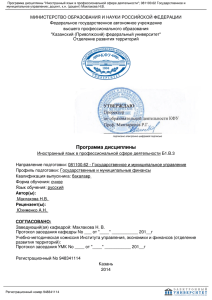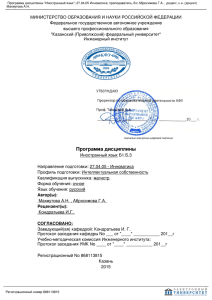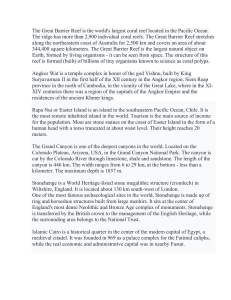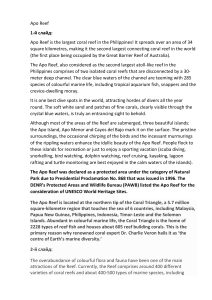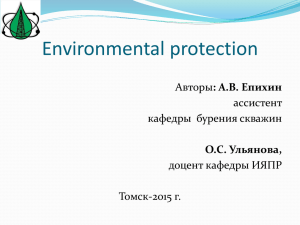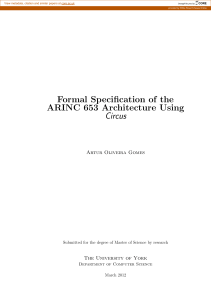Документ 2236871
Реклама
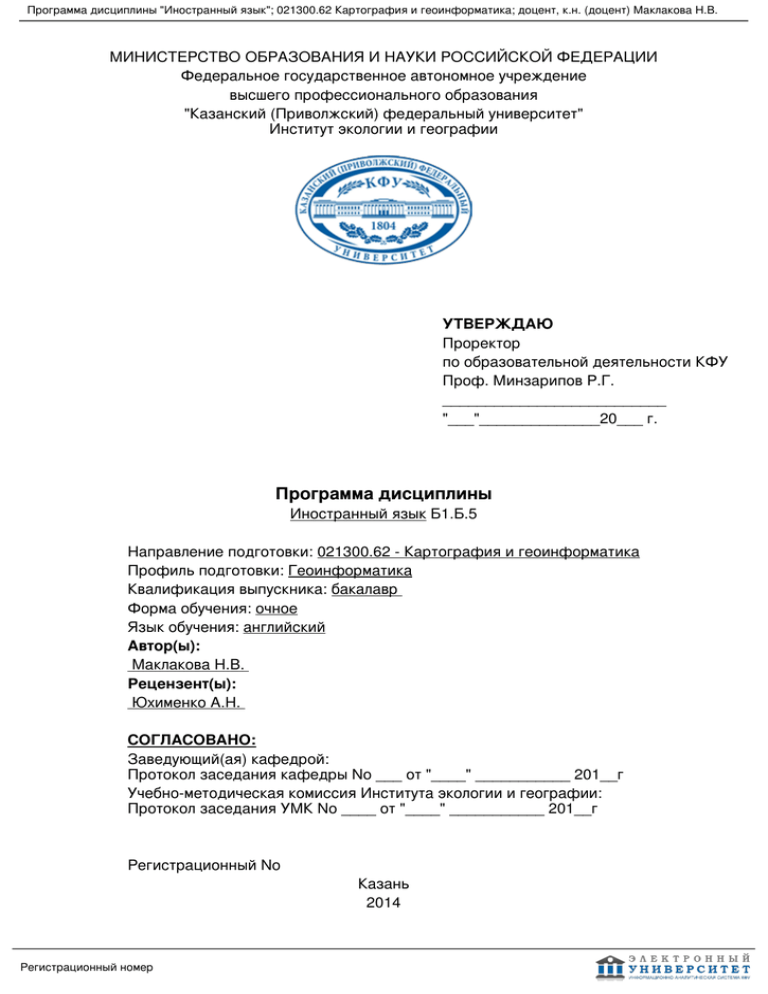
Программа дисциплины "Иностранный язык"; 021300.62 Картография и геоинформатика; доцент, к.н. (доцент) Маклакова Н.В. МИНИСТЕРСТВО ОБРАЗОВАНИЯ И НАУКИ РОССИЙСКОЙ ФЕДЕРАЦИИ Федеральное государственное автономное учреждение высшего профессионального образования "Казанский (Приволжский) федеральный университет" Институт экологии и географии УТВЕРЖДАЮ Проректор по образовательной деятельности КФУ Проф. Минзарипов Р.Г. __________________________ "___"______________20___ г. Программа дисциплины Иностранный язык Б1.Б.5 Направление подготовки: 021300.62 - Картография и геоинформатика Профиль подготовки: Геоинформатика Квалификация выпускника: бакалавр Форма обучения: очное Язык обучения: английский Автор(ы): Маклакова Н.В. Рецензент(ы): Юхименко А.Н. СОГЛАСОВАНО: Заведующий(ая) кафедрой: Протокол заседания кафедры No ___ от "____" ___________ 201__г Учебно-методическая комиссия Института экологии и географии: Протокол заседания УМК No ____ от "____" ___________ 201__г Регистрационный No Казань 2014 Регистрационный номер Программа дисциплины "Иностранный язык"; 021300.62 Картография и геоинформатика; доцент, к.н. (доцент) Маклакова Н.В. Содержание 1. Цели освоения дисциплины 2. Место дисциплины в структуре основной образовательной программы 3. Компетенции обучающегося, формируемые в результате освоения дисциплины /модуля 4. Структура и содержание дисциплины/ модуля 5. Образовательные технологии, включая интерактивные формы обучения 6. Оценочные средства для текущего контроля успеваемости, промежуточной аттестации по итогам освоения дисциплины и учебно-методическое обеспечение самостоятельной работы студентов 7. Литература 8. Интернет-ресурсы 9. Материально-техническое обеспечение дисциплины/модуля согласно утвержденному учебному плану Регистрационный номер Страница 2 из 16. Программа дисциплины "Иностранный язык"; 021300.62 Картография и геоинформатика; доцент, к.н. (доцент) Маклакова Н.В. Программу дисциплины разработал(а)(и) доцент, к.н. (доцент) Маклакова Н.В. Кафедра английского языка Институт языка , Natalia.Maklakova@kpfu.ru 1. Цели освоения дисциплины - лингвистического - это владение знанием о системе языка, о правилах функционирования единиц языка в речи и способность с помощью этой системы понимать чужие мысли и выражать собственные суждения в устной и письменной форме; - социолингвистического, что означает знание способов формирования и формулирования мыслей с помощью языка, а также способность пользоваться языком в речи; - социокультурного, который подразумевает знание учащимися национально-культурных особенностей социального и речевого поведения носителей языка: их обычаев, этикета, социальных стереотипов, истории и культур, а также способов пользоваться этими знаниями в процессе общения; - стратегического - это компетенция, с помощью которой учащийся может восполнить пробелы в знании языка, а также речевом и социальном опыте общения в иноязычной среде; - социального, который проявляется в желании и умении вступать в коммуникацию с другими людьми, в способности ориентироваться в ситуации общения и строить высказывание в соответствии с коммуникативным намерением говорящего и ситуацией; - дискурсивного, который предполагает навыки и умения организовывать речь, логически, последовательно и убедительно ее выстраивать, ставить задачи и добиваться поставленной цели, а также владение различными приемами получения и передачи информации как в устном, так и в письменном общении; - межкультурного, подразумевающего действия в рамках культурных норм, принятых в культуре изучаемого иностранного языка и умений, позволяющих представлять культуру родного языка средствами иностранного. 2. Место дисциплины в структуре основной образовательной программы высшего профессионального образования Данная учебная дисциплина включена в раздел " Б1.Б.5 Гуманитарный, социальный и экономический" основной образовательной программы 021300.62 Картография и геоинформатика и относится к базовой (общепрофессиональной) части. Осваивается на 1, 2 курсах, 1, 2, 3, 4 семестры. Данная дисциплина является обязательной составляющей базового цикла всех направлений подготовки бакалавра. Иностранный язык является важнейшим инструментом успешной межкультурной коммуникации и необходимым средством обмена информацией в глобальном масштабе, что делает его неотъемлемой частью подготовки конкурентоспособного специалиста любого профиля. 3. Компетенции обучающегося, формируемые в результате освоения дисциплины /модуля В результате освоения дисциплины формируются следующие компетенции: В результате освоения дисциплины студент: 1. должен знать: - понимать и уметь употребить в речи знакомые фразы и выражения, необходимые для выполнения конкретных задач; уметь представиться/ представить других, задавать/ отвечать на вопросы о месте жительства, знакомых, имуществе; участвовать в несложном разговоре, если собеседник говорит медленно и отчетливо и готов оказать помощь в ситуациях повседневного общения, когда говорят о нем, его семье и ближайшем окружении; Регистрационный номер Страница 3 из 16. Программа дисциплины "Иностранный язык"; 021300.62 Картография и геоинформатика; доцент, к.н. (доцент) Маклакова Н.В. - понимать знакомые имена, слова, а также очень простые предложения в объявлениях, на плакатах или каталогах; принимать участие в диалоге, если собеседник повторяет по его просьбе в замедленном темпе свое высказывание или перефразирует его, а также помогает сформулировать то, что обучающийся пытается сказать; уметь задавать простые вопросы и отвечать на них в рамках известных или интересующих его тем - понимать отдельные предложения и часто встречающиеся выражения связанные с основными сферами жизни (например, основные сведения о себе и членах своей семьи, покупках, устройстве на работу и т.п.); уметь выполнить задачи, связанные с простым обменом информации на знакомые или бытовые темы. В простых выражениях способен рассказать о себе, своих родных и близких, описать основные аспекты повседневной жизни; - способен понимать отдельные фразы и наиболее употребительные слова в высказываниях, касающихся важных для обучающегося тем (например, основную информацию о себе и своей семье, о покупках, о месте, где живет, о работе); понимать, о чем идет речь в простых, четко произнесенных и небольших по объему сообщениях и объявлениях; - воспринимать очень короткие простые тексты; уметь найти конкретную, легко предсказуемую информацию в простых текстах повседневного общения: в рекламах, проспектах, меню, расписаниях; в простых письмах личного характера; 2. должен уметь: - уметь, используя простые фразы и предложения, рассказать о месте, где живет, и людях, которых он знает; - уметь писать простые открытки (например, поздравление с праздником), заполнять формуляры, вносить свою фамилию, национальность, адрес в регистрационный листок в гостинице. - уметь общаться в простых типичных ситуациях, требующих непосредственного обмена информацией в рамках знакомых тем и видов деятельности; способен поддерживать предельно краткий разговор на бытовые темы, но недостаточно, чтобы самостоятельно вести беседу; - уметь, используя простые фразы и предложения, рассказать о своей семье и других людях, условиях жизни, учебе, настоящей или прежней работе; - уметь писать простые короткие записки и сообщения; написать несложное письмо личного характера (например, выразить кому-либо свою благодарность за что-либо). 3. должен владеть: - владеть техникой написания эссе или докладов, освещая вопросы или аргументируя точку зрения "за" или "против"; писем, выделяя те события и впечатления, которые являются для обучающегося особо важными. 4. Структура и содержание дисциплины/ модуля Общая трудоемкость дисциплины составляет 12 зачетных(ые) единиц(ы) 432 часа(ов). Форма промежуточного контроля дисциплины отсутствует в 1 семестре; зачет во 2 семестре; отсутствует в 3 семестре; экзамен в 4 семестре. Суммарно по дисциплине можно получить 100 баллов, из них текущая работа оценивается в 50 баллов, итоговая форма контроля - в 50 баллов. Минимальное количество для допуска к зачету 28 баллов. 86 баллов и более - "отлично" (отл.); 71-85 баллов - "хорошо" (хор.); 55-70 баллов - "удовлетворительно" (удов.); Регистрационный номер Страница 4 из 16. Программа дисциплины "Иностранный язык"; 021300.62 Картография и геоинформатика; доцент, к.н. (доцент) Маклакова Н.В. 54 балла и менее - "неудовлетворительно" (неуд.). 4.2 Содержание дисциплины 5. Образовательные технологии, включая интерактивные формы обучения В основе учебного процесса - практические занятия. В процессе обучения иностранному языку используются разнообразные формы проведения занятий: индивидуальная, парная, групповая и командная работа, ролевые игры, творческие задания, компьютерные симуляции, эссе, устные и письменные презентации по различной тематике, соревнования, конкурсы. При этом широко используются разнообразные мультимедийные средства обучения. 6. Оценочные средства для текущего контроля успеваемости, промежуточной аттестации по итогам освоения дисциплины и учебно-методическое обеспечение самостоятельной работы студентов Примерные вопросы к зачету и экзамену: БАЗОВЫЙ БЛОК B1 Reading Question ?1 ?2 ?3 ?4 ?5 ?6 ?7 You are going to read an article about a woman who owns a circus. Seven sentences have been removed from the article. Choose from the sentences A-H the one which fits each gap (1-7). There is one extra sentence which you do not need to use. A It was there that she learned the skill of haute école - making a horse perform on its back legs. B The tent can only hold a maximum of 250 people, so the atmosphere is close and intimate. C Entering the ring for the first time as a performer was a fantastic thrill. D We feel we are putting something back into these communities that has been missing for some time. E We always look for the best of new and traditional circus, but the problem is that many of the best acts go abroad. F There were very few signs that this fairly traditional upbringing would lead a rather shy young girl to a career in the circus. G But winter is also a busy time, and is in fact when Nell is at her most frantic, researching, designing and preparing the next show. H There are no wild animals, but horses play a leading role in the performances, and Nell herself is an expert rider. Регистрационный номер Страница 5 из 16. Программа дисциплины "Иностранный язык"; 021300.62 Картография и геоинформатика; доцент, к.н. (доцент) Маклакова Н.В. Life in the big top with Giffords Circus Nell Gifford lives a childhood fantasy - as a ringmaster. The drum rolls, the curtains open, and a horse rears into the spotlight. Nell Gifford, a statuesque 27-year-old, is riding the horse. The crowd cheers and, with a thumping heart, she begins: 'Ladies and gentlemen, boys and girls welcome to Giffords Circus'. The ringmistress, Nell Gifford, is the only female circus owner in Europe. She and her husband Toti started the business just a few years ago. Since then, they have created one of the most successful shows in the country. Their performances are always sold out, and they recently so impressed their colleagues that they were awarded the prestigious Jerwood circus award. If the word 'circus' conjures up images of aggressive clowns and sick-looking lions, think again. 1 The other acts are a mixture of theatre, dance and traditional circus skills such as juggling and acrobatics, all accompanied by a circus band. The show is based on old circuses from the 1930s and much of its appeal comes from its size. 2 The ring is also fairly small, and the audience can almost reach out and touch the performers as they move around. This creates a real feeling of belonging; as Nell points out 'There are no tricks, no hiding behind lights. It's all pretty raw.' From May to September, the circus travels around the countryside, stopping in small villages all over the south of England. 'Villages today need live entertainment,' says Nell 'and a good circus in a village provides a focal point for everyone. 3 And we know from people's reactions that villagers really appreciate what we are trying to do. Nell's route into the business was an unusual one. She had an idyllic childhood in the English countryside, growing up with horses and ponies. Later she went to Oxford University, where she studied English Literature. 4 That all changed when she went to America at the age of 18 and joined Circus Flora, which was owned by a distant relative. 'I went there for no other reason than the promise of adventure in the USA,' says Nell 'but from day one, there was no question that this was what I wanted to do. 5 It felt as if the rest of my life had just started.' From then on she spent all her free time working in circuses, learning as much as she could about the business. When she was back in Europe, she joined the acclaimed Circus Roncalli to develop her riding skills even more. 6 Her fianceé Toti frequently visited and became entranced by the lifestyle, and it was then that they began to make plans to set up a circus of their own. For Nell and Toti, the success of their circus is a dream come true, but it also involves a great deal of work. Summer is filled with the challenges of keeping the show on the road, moving every few days, keeping the performers happy, and managing the day-to-day aspects of the business. 7 There are no definite plans for the future, but why should there be, as life on the road is only just beginning? Giffords Circus is going from strength to strength, and promises many exciting summers for years to come. B1 Use of English Question ?1 ?2 ?3 ?4 ?5 ?6 ?7 ?8 ?9 ? 10 For questions 1-10, read the text below. Use the word given in capitals at the end of some of the lines to form a word that fits in the gap in the same line. Регистрационный номер Страница 6 из 16. Программа дисциплины "Иностранный язык"; 021300.62 Картография и геоинформатика; доцент, к.н. (доцент) Маклакова Н.В. PlayStation? thumb A 13-year-old girl from Durban has become the 1 YOUNG person to have had a 2 accepted by the CONTRIBUTE 3 respected South African Medical Journal. INTERNATIONAL Safura Karim 4 did her research into 'PlayStation? Thumb' ORIGIN as part of a school project. It gives details of the injuries that many of her schoolmates 5 suffer from, and which are REGULAR caused by the 6 use of computer games for hours and hours. INTERRUPT Safura thinks that computer games are 7 and does not own POINT a PlayStation herself. She said that she was 8 to hear that her article had been DELIGHT accepted by the journal. She comes from a 9 family - her SCIENCE parents are both 10 , and she is hoping to become a doctor. RESEARCH B2 Use of English ? Question ?1 ?2 ? 3.. ?4 ?5 ?6 ?7 ?8 ?9 ? 10 ? 11 ? 12 For questions 1-12, read the text below and decide which word best fits each gap The Black Sea Arriving in the Black Sea port of Batumi was a dream 1 ________ true for me. For years I had longed to 2 ________ slowly along the promenade 3 ________ out over this landlocked sea, so as I headed to the coast, I felt both excited and strangely nervous. According 4 _________ my guidebook, the Black Sea is more like a lake than a sea. It has no tides, and, thanks to modern 5 _________, we now know that below a certain depth it is too poisonous to sustain life. But its calm surface gives a false 6 __________; on stormy days, the churning waters can have a 7 __________ effect on shipping. Регистрационный номер Страница 7 из 16. Программа дисциплины "Иностранный язык"; 021300.62 Картография и геоинформатика; доцент, к.н. (доцент) Маклакова Н.В. My travelling companion and I had bought cheap tickets on the overnight train from Tbilisi, the capital of Georgia. By the time we arrived in Batumi, we were so tired and hungry that we virtually 8 _______ off the train. We had a few 9 _________ to eat from the previous night's meal, but nothing appetising. We had a very 10 _________ time that first evening though, excited 11 __________ the thought of being by the sea where once, 12 __________ the sudden storms, Ancient Greeks traded and Byzantine ships patrolled the shores. A2 Reading Passage 1 has nine paragraphs A-I. Choose the most suitable headings for each paragraph from the list of headings given. 1 Paragraph A ? Island legends ? Resources for exchange ? Competition for fishing rights ? The low cost of equipment ? Agatti's favourable location ? Rising income levels ? The social nature of reef occupations ? Resources for islanders' own use ? High levels of expertise ? Alternative sources of employment ? Resources for earning money ? Social rights and obligations The coral reefs of Agatti Island A Agatti is one of the Lakshadweep Islands off the south-west coast of India. These islands are surrounded by lagoons and coral reefs which are in turn surrounded by the open ocean. Coral reefs, which are formed from the skeletons of minute sea creatures, give shelter to a variety of plants and animals, and therefore have the potential to provide a stream of diverse benefits to the inhabitants of Agatti Island. B In the first place, the reefs provide food and other products for consumption by the islanders themselves. Foods include different types of fish, octopus and molluscs, and in the case of poorer families these constitute as much as 90% of the protein they consume. Reef resources are also used for medicinal purposes. For example, the money cowrie, a shell known locally as Vallakavadi, is commonly made into a paste and used as a home remedy to treat cysts in the eye. C In addition, the reef contributes to income generation. According to a recent survey, 20% of the households on Agatti report lagoon fishing, or shingle, mollusc, octopus and cowrie collection as their main occupation (Hoon et al, 2002). For poor households, the direct contribution of the reef to their financial resources is significant: 12% of poor households are completely dependent on the reef for their household income, while 59% of poor households rely on the reef for 70% of their household income, and the remaining 29% for 50% of their household income. D Bartering of reef resources also commonly takes place, both between islanders and between islands. For example, Agatti Island is known for its abundance of octopus, and this is often used to obtain products from nearby Androth Island. Locally, reef products may be given by islanders in return for favours, such as help in constructing a house or net mending, or for other products such as rice, coconuts or fish. Регистрационный номер Страница 8 из 16. Программа дисциплины "Иностранный язык"; 021300.62 Картография и геоинформатика; доцент, к.н. (доцент) Маклакова Н.В. E The investment required to exploit the reefs is minimal. It involves simple, locally available tools and equipment, some of which can be used without a boat, such as the fishing practice known as Kat moodsal. This is carried out in the shallow eastern lagoon of Agatti by children and adults, close to shore at low tide, throughout the year. A small cast net, a leaf bag, and plastic slippers are all that are required, and the activity can yield 10-12 small fish (approximately 1 kg) for household consumption. Cast nets are not expensive, and all the households in Agatti own at least one. Even the boats, which operate in the lagoon and near-shore reef, are constructed locally and have low running costs. They are either small, non-mechanical, traditional wooden rowing boats, known as Thonis, or rafts, known as Tharappam. F During more than 400 years of occupation and survival, the Agatti islanders have developed an intimate knowledge of the reefs. They have knowledge of numerous different types of fish and where they can be found according to the tide or lunar cycle. They have also developed a local naming system or folk taxonomy, naming fish according to their shape. Sometimes the same species is given different names depending on its size and age. For example, a full grown Emperor fish is called Metti and a juvenile is called Killokam. The abundance of each species at different fishing grounds is also well known. Along with this knowledge of reef resources, the islanders have developed a wide range of skills and techniques for exploiting them. A multitude of different fishing techniques are still used by the islanders, each targeting different areas of the reef and particular species. G The reef plays an important role in the social lives of the islanders too, being an integral part of traditions and rituals. Most of the island's folklore revolves around the reef and sea. There is hardly any tale or song which does not mention the traditional sailing crafts, known as Odams, the journeys of enterprising 'heroes', the adventures of sea fishing and encounters with sea creatures. Songs that women sing recollect women looking for returning Odams, and requesting the waves to be gentler and the breeze just right for the sails. There are stories of the benevolent sea ghost baluvam, whose coming to shore is considered a harbinger of prosperity for that year, bringing more coconuts, more fish and general well-being. H The reef is regarded by the islanders as common property, and all the islanders are entitled to use the lagoon and reef resources. In the past, fishing groups would obtain permission from the Amin (island head person) and go fishing in the grounds allotted by him. On their return, the Amin would be given a share of the catch, normally one of the best or biggest fish. This practice no longer exists, but there is still a code of conduct or etiquette for exploiting the reef, and common respect for this is an effective way of avoiding conflict or disputes. I Exploitation of such vast and diverse resources as the reefs and lagoon surrounding the island has encouraged collaborative efforts, mainly for purposes of safety, but also as a necessity in the operation of many fishing techniques. For example, an indigenous gear and operation known as Bala fadal involves 25-30 men. Reef gleaning for cowrie collection by groups of 6-10 women is also a common activity, and even today, although its economic significance is marginal, it continues as a recreational activity. A2 Reading Question ?1 ?2 ?3 ?4 ?5 ?6 ?7 ?8 ?9 ? ... Регистрационный номер Страница 9 из 16. Программа дисциплины "Иностранный язык"; 021300.62 Картография и геоинформатика; доцент, к.н. (доцент) Маклакова Н.В. ? 13 Choose the correct answer, A, B, C, or D. 1 What does the author say in paragraph 1 about the date July 4, 1845? A Thoreau possibly decided to move on that day because it was Independence Day. B Thoreau was not able to move on that date because it was a national holiday. C Thoreau began to construct his cabin near Walden Pond on that day. D Thoreau agreed to buy land on Walden Pond from Emerson on that date. On Walden Pond 1 During his lifetime, Henry David Thoreau wrote over twenty books?travel books, books of poetry, and collections of essays?but none has had such a lasting influence as Walden, an account of the time he spent in a tiny house on the shore of Walden Pond near Concord, Massachusetts. Born in 1817 in Concord, Thoreau graduated from Harvard University in nearby Cambridge, Massachusetts. When he returned to Concord, he worked for his father, who manufactured pencils, and tutored the children of writer Ralph W. Emerson, Thoreau's friend and mentor. Thoreau then decided to move to a relatively isolated one-room cabin in the woods just outside of Concord on land owned by Emerson. Thoreau began clearing the land and building the cabin in the spring of 1845 and, perhaps significantly, he chose to move in on July 4 of that year?on the holiday celebrating the independence of the United States in 1776. He lived on the pond for two years, but in Walden, he compresses that time into a single year. 2 Thoreau wrote in Walden, "I went to the woods because I wished to live deliberately . . . and not, when I came to die, discover that I had not lived." Essentially, Walden is Thoreau's description of an experiment in self-reliance and in living the simple life. He believed that owning anything beyond the basic necessities of life was an obstacle to a happy life rather than an advantage. He wrote, "I see young men . . . whose misfortune it is to have inherited farms, houses, barns, cattle, and farming tools; for these are more easily acquired than got rid of." He built his own house for a mere $28.13 (about $300.00 in today's dollars). He grew beans and other vegetables, which he sold for a modest profit. In Walden, he includes a rather lengthy, detailed reckoning of how much he spent and how much he earned, information which some readers find tedious. He spent the rest of his time at the pond walking in the woods, reading, and writing a book about a canoe trip with his brother, A Week on the Concord and Merrimack Rivers. 3 Although Thoreau valued solitude and spent much time alone, he was not completely cut off from society. His cabin was close to the road to Concord and he often walked to town to do business and have dinner with family or friends. He entertained visitors at his cabin and his mother sometimes brought him meals. Richard Zachs, a contemporary critic, says that it was like "suburban boys going to their tree house in the backyard and pretending they're camping in the heart of the jungle." 4 Thoreau had an ambivalent attitude towards technology. He invented a method of making pencils from low-grade clay for use in his father's factory. But he was suspicious of the greatest technological innovations of his time, the telegraph and the railroad. He pointed out in Walden that the nation was hastily building a telegraph system that would soon link the country from Maine to Texas, but Thoreau said "Maine and Texas, it may be, have nothing important to communicate." He believed that trains gave people an illusion of freedom, but in fact represented a new servitude, because it meant obeying fixed train schedules and routes. He also wrote that he found a "train" of clouds moving across the sunrise of much more interest than a train of railroad cars going to Boston. 5 Thoreau was a dedicated student of nature. Walden is filled with minute observations of animals, plants, and weather. He wrote, "For years I was a self-appointed inspector of snowstorms and rainstorms." When writing about animals, he would relate their behavior to that of humans, as in his fascinating account of war between red and black ants. His writings about the "interconnectedness" of nature anticipate the environmental movement by about 125 years. Регистрационный номер Страница 10 из 16. Программа дисциплины "Иностранный язык"; 021300.62 Картография и геоинформатика; доцент, к.н. (доцент) Маклакова Н.В. 6 Like his fellow New Englander, twentieth-century poet Robert Frost, Thoreau wrote in a style that seems folksy on the surface, but it contains wit and symbolism. Thoreau sprinkled his prose with classical allusions as well as with word play and puns, some of which are difficult for today's readers to comprehend. Thoreau can be poetic too, as when he beautifully describes ice on the pond. But despite the clarity of his writing, Walden is not an easy book, especially for first time readers. It has no plot line, no real characters outside of Thoreau himself, and even the most enthusiastic Thoreau admirer would probably agree that some of his descriptions of ponds, woods and storms go on too long. But it is an important book, and definitely worth the effort. Критерии оценки устного монологического высказывания: 1.Беглость речи 2. Лексическая грамотность изложения 3. Словарная наполняемость и целесообразность использования языковых средств 4. Полнота раскрытия темы 5. Структурная организация высказывания Критерии оценки устного диалогического высказывания: 1.Беглость речи 2. Лексическая грамотность изложения 3. Словарная наполняемость и целесообразность использования языковых средств 4. Полнота раскрытия темы 5. Структурная организация высказывания 6. Стремление к коммуникативному партнерству Профессионально-ориентированный блок Пример грамматического теста 1. Analyze the following sentences and translate them into Russian: 1. The man addressed by him turned out to be a teacher. 2. Having been sent only yesterday the letter could not have been received this morning. 3. Their work completed the assistants left. 4. The figure represented an animal, its total length being two and a half inches. 5. I happened to look back and saw the men getting in and the car starting. 6. The problems to be discussed were of great importance. 7. Historians appear to know but little of his life. 8. All this, were it to happen to me now, would seem perfectly natural and normal. 9. Now we see that she does know the subject well. 10. It is by no means unreasonable to compare these data. Пример текста на устное реферирование Banks make their profits by lending the money which customers de?posit with them to others who need it for personal or business reasons. Most people need more money than they have currently available at some time in their lives. To be a borrower you must be a customer of the bank because the money will be lent to you through a bank account. There are two ways in which you may borrow. The first, and easy, is to spend more money than you have in your current account ? to overdraw. The second, and the normal way of borrowing larger amounts or for a long period of time is the loan. If a manager permits an overdraft on current account he is likely to set a limit to the size of the overdraft and may stipulate a date by which the account is back in credit. Businesses whose payments and receipts are often irregular will frequently need to use overdraft facilities and they are often granted to private customers as well particularly when the manager knows that regular payments are made directly into the account. Регистрационный номер Страница 11 из 16. Программа дисциплины "Иностранный язык"; 021300.62 Картография и геоинформатика; доцент, к.н. (доцент) Маклакова Н.В. If a loan is granted it will be a fixed sum immediately available for a fixed period of time. The principal and the interest on it may all become due for payment at the end of that period but for personal loans it is common to arrange that the loan and interest are repaid in equal regu?lar installments over the period of the loan. A separate account is opened to record the repayments as they are made. Пример текста на перевод со словарем Translate the following text into Russian The hottest debate over the world economy is not on the fate of America; it's on the fate of China. Will it be the worst victim, or the most successful survivor, of the global crisis of 2009? So far the news all points to success, as the Asian giant defies the old assumption that an American recession would trigger a Chinese depression. Long dependent on exports to America, China continues to grow strongly despite a collapse of exports, down 26.4 percent in May alone. The reason is growth at home, with retail sales up 15.2 percent in May, and house and car sales taking off. To some, this is evidence that China has hit a new state of development, emerging as a consumer society wealthy enough to rival America as the world's best customer, and in some ways it has. The problem is that the consumer driving the boom is not the individual, because the Chinese shopper has been in retreat in recent years. The real big spender is the government. China's economic recovery is real, but it's been bought by the state. No political party in the world can spend quite as freely right now as China's Communist Party, with its nearly $2 trillion in reserves and budget authority unchecked by rival parties or institutions. Beijing's stimulus plan amounts to 4 percent of GDP, double America's 2 percent, and China can deliver this booster shot without resorting to foreign borrowing. Government investment has driven the Chinese boom for a long time, and it is up 30 percent since the beginning of the year, with 75 percent of the money going into infrastructure; spending on rail lines and roads has more than doubled over the past 12 months. New community centers, convention halls, and sports facilities are springing up in major cities and provinces. Central and local governments are raising subsidies to support idle factories, retrain workers, and boost income aid in hard-hit areas. New government lending, as well as government orders to banks to raise lending, is helping to spur a surge in apartment sales. The state is even handing out spending vouchers directly to consumers, particularly in rural areas, good for cars, refrigerators, and other products, many with price restrictions that effectively limit the vouchers to inexpensive Chinese brands. As a top executive at one Chinese state-owned bank puts it, "This is all about the government propping things up." The hidden hand of the state can obscure the degree to which China still depends on subsidized exports to America. Among the hardest-hit areas are those such as Guangdong province, a southern factory hub that represents an eighth of China's wealth and a quarter of its exports. There five-star hotels built in the boom times stand empty, while job centers for laid-off migrant workers are full. On a recent evening, the Pearl River itself seemed dimmer?many of the garish light displays that usually blaze from waterfront inns and restaurants had been turned off "to save electricity," says Su Caifang, deputy director general of the Guangdong Foreign Affairs Office, who notes that the province has suffered greatly in recent months because of the global downturn. "We're still very export-dependent, especially on America," says Su, who notes that 40 percent of the region's exports go to the U.S. 6.2 Методические рекомендации по изучению английского языка для студентов Слова: как запоминать слова? ? Попробовать прочитать, повторить за диктором, написать на карточку с соответствующими грамматическими формами. ? Комбинировать: по родам, по смысловым группам. ? Придумать историю. 1. сделайте карточки со словами, которые Вы хотите выучить. Всегда проговаривайте слова вслух! Какие слова трудны? Наклейте их, например, мебель, на соответствующие предметы. 2. напишите новое слово с артиклем на карточке, отметьте ударение. На обороте напишите перевод. По мере запоминания слова перемещайте карточки в Вашем словаре. 3. из журналов или интернета подберите картинки к словам, которые Вы хотели бы выучить или нарисуйте сами. На обороте напишите нужное Вам слово. Регистрационный номер Страница 12 из 16. Программа дисциплины "Иностранный язык"; 021300.62 Картография и геоинформатика; доцент, к.н. (доцент) Маклакова Н.В. 4. слова учите всегда с грамматическими формами: существительные - артикль=род и множественное число, глаголы - три основные временнее формы и т.п. 5. метод пантомимы: жестами изобразите слова и понятия, которые надо запомнить. 6. метод группы: разбейте слова на смысловые группы, например, фрукты, приборы, напитки и т.д. В один прием запоминайте слова только одной группы, затем делайте перерыв. 7. метод историй: с новыми словами придумывайте маленькие истории, объединяя 7-9 новых слов в одной. Чтение//Текст: Чтение поисковое Чтение сообщим охватом содержания Чтение на скорость Читать по предложениям несколько раз. Читать, закрывая половину строки Чтение с ограничением времени. 1. чтение начинается с названия текста: какую информацию оно несет, что будет дальше? 2. сделайте текст интересным для себя 3. задания к тексту помогают понять его: предтекстовые снимают трудности, по тексту заставляют быть внимательным. 4. Читайте дважды! При первом прочтении обращайте внимание на интернациональные слова, которые помогают читать, не спешите заглядывать в словарь, попробуйте догадаться о значении слова по контексту. Непонятно? - тогда смело ищите слово в словаре. 5. перед пересказом прочтите еще раз: сделайте скелет текста, выбирая ключевые слова. 6. прочтите еще раз, если Вам трудно установить связи. Подчеркивайте все слова, которые Вы быстро "узнаете". 7. если Вы сделали все задания к тексту, тогда пересказ готов! Аудирование//текст Обще понимание 1. ответьте мысленно на вопросы: кто, где, когда? 2. какие эмоции вызывает услышанное у Вас? Избирательное понимание 1. Прослушивание может быть поэтапным: 2-3 разовое 2. при первом прослушивании ответьте на вышеупомянутые 2 вопроса. 3. при повторном прослушивании сначала прочтите задания и постарайтесь ответить на них, затем прослушайте текст, выполняя данные задания. В зависимости от количества заданий текст может быть повторно прослушан либо по частям, либо полностью. Полное понимание Для данного вида аудирования полезными будут все вышеизложенные указания. Дополнительно во время повторного прослушивания рекомендуется составить план и выписать по ходу звучания ключевые слова. Письмо Перед письменными работами рекомендуется просмотреть тот материал, по которому проводиться данная работа. При написании творческой работы, предварительно необходимо сформулировать тему и аргументирование, т.е. составить развернутый план, а затем приступать к ее написанию. 7.1. Основная литература: 1.Учебник по ESP (в зависимости от специальности) 2.Учебник по ESL (в зависимости от специальности) Регистрационный номер Страница 13 из 16. Программа дисциплины "Иностранный язык"; 021300.62 Картография и геоинформатика; доцент, к.н. (доцент) Маклакова Н.В. 3.Добронецкая Э.Г. Грамматические трудности английского языка. - Казань: Изд-во КГУ, 2001. 4.Дорожкина В.П. Английский язык для студентов-математиков. - М.: Астрель, 2006. 5.Дроздова Е.Ю.,Берестова А.И., Маилова И.Г. English Grammar: Reference and Practice. СПб: Антология, 2004.-400 с 6.Acklam R.,Crace A.Total English: Pre-Intermediate Student's Book. - Longman, 2007. 7.Acklam R.,Crace A.Total English: Pre-Intermediate Work Book. - Longman, 2007. 8.Acklam R.,Crace A.Total English: Intermediate Student's Book. - Longman, 2007. 9.Acklam R.,Crace A.Total English: -Intermediate Workbook Book. - Longman, 2007. 10.Carr J. C., Cunningham S., Moor P. Cutting Edge: Pre-Intermediate Student's Book. - Essex: Pearson Education, 2001. 11.Carr J. C., Cunningham S., Moor P. Cutting Edge: Pre-Intermediate Teacher's Resource Book (+ set of 2 class cassettes). - Essex: Pearson Education 2001. 12.Carr J. C., Cunningham S., Moor P. Cutting Edge: Pre-Intermediate Workbook. - Essex: Pearson Education 2001. 13.Cunningham S., Moor P. Cutting Edge: Intermediate Student's Book. - Essex: Pearson Education 2000. 14.Cunningham S., Moor P. Cutting Edge: Intermediate Teacher's Resource Book (+ set of 2 class cassettes). - Essex: Pearson Education 2000. 15.Cunningham S., Moor P. Cutting Edge: Intermediate Workbook. - Essex: Pearson Education 2000. 16.Frances E. Cutting Edge: Pre-Intermediate Tests. - Essex: Pearson Education 2001. 17.Frances E. Cutting Edge: Intermediate / Upper-Intermediate Tests. - Essex: Pearson Education 1999. 18.Hannock M. English Pronunciation in Use. - Cambridge: Cambridge University Press, 2006. 19.Hewings M. Advanced Grammar in Use. - Cambridge: Cambridge University Press, 2002. 20.Hall E., Mascull B., Riley D.Market Leader: Pre-Intermediate Student's Book. - Longman, 2006. 21.Hall E., Mascull B., Riley D.Market Leader: Pre-Intermediate Workbook. - Longman, 2006. 22.Hall E., Mascull B., Riley D.Market Leader: Intermediate Student's Book. - Longman, 2006. 23.Hall E., Mascull B., Riley D.Market Leader: Intermediate Workbook. - Longman, 2006. 24.Hall E., Mascull B., Riley D.Market Leader: Upper-Intermediate Student's Book. - Longman, 2006. 25.Hall E., Mascull B., Riley D.Market Leader: Upper-Intermediate Workbook. - Longman, 2006. 26.Murphy R. English Grammar in Use. - N.Y.: Cambridge University Press, 1996. 27.Oxenden C., Latham-Koenig Ch., Seligson P. New English File Pre-Intermediate Student's Book. - Oxford University press, 2005. 28.Oxenden C., Latham-Koenig Ch. New English File Intermediate Student's Book. - Oxford University press, 2006. 29.Oxenden C., Latham-Koenig Ch. New English File Upper-Intermediate Student's Book. - Oxford University press, 2007. 30.Stanton A., Morris S. Fast track to CAE Coursebook- Essex: Pearson Education 2003 Stanton A., Morris S. Fast track to CAE Workbook- Essex: Pearson Education 2003. 7.2. Дополнительная литература: 1.Гальскова Н.Д., Гез Н.И. Теория обучения иностранным языкам: Лингводидактика и методика. - М.: Издательский центр "Академия", 2005. - 336 с 2.Михайлов Н.Н., Михайлов М.Н. Лингвострановедение США.- М: Академия,2008.-268 с. 3.Щукин А.Н. Лингводидактический энциклопедический словарь. - М.: Астрель,: АСТ: Хранитель, 2007. - 746с. Регистрационный номер Страница 14 из 16. Программа дисциплины "Иностранный язык"; 021300.62 Картография и геоинформатика; доцент, к.н. (доцент) Маклакова Н.В. 4.Hall E., Mascull B., Riley D.Market Leader: Pre-Intermediate Teacher's Book. - Longman, 2006. 5.Hall E., Mascull B., Riley D.Market Leader: Intermediate Teacher's Book. - Longman, 2006. 6.Hall E., Mascull B., Riley D.Market Leader: Upper-Intermediate Teacher's Book. - Longman, 2006. 7.Johnston O., Farrell M. Ideas and Issues: Intermediate. - London: Chancerel, 1998. 8.Oxenden C., Latham-Koenig Ch. New English File Upper-Intermediate Teacher's Book. - Oxford University press, 2007. 9.Rinvolucri M. Grammar Games: cognitive, Affective and drama Activities for EFL Students. - N.Y.: Cambridge University Press, 1995. 10.Rundell M. Cutting Edge: Mini-Dictionary. Pre-Intermediate. - Essex: Pearson Education 2001. 11.Rundell M. Cutting Edge: Mini-Dictionary. Intermediate. - Essex: Pearson Education 2000 Oxenden C., Latham-Koenig Ch., Seligson P. New English File Pre-Intermediate Teacher's Book. Oxford University press, 2005. 12.Oxenden C., Latham-Koenig Ch. New English File Intermediate Teacher's Book. - Oxford University press, 2006. 13. Stanton A., Morris S. Fast track to CAE Teacher's book- Essex: Pearson Education 2003. 14. Stanton A., Morris S. Fast track to CAE Teacher's book- Essex: Pearson Education 2003. Словари и справочные издания: 1. A. J. Lohwater's Russian - English Dictionary of Mathematical Sciences / Ed. by R.P. Boas - М.: "Центр Моделирования", 1990. 2. Longman Dictionary of Contemporary English. - Essex: Pearson Education 2001. 3. Oxford Guide To British and American Culture for Learners of English / Ed. by J.Crowther and K. Kavanagh - New York: Oxford University Press, 2001. Периодические издания: 1. English: "Английский язык" газета издательского дома "Первое сентября". -М. 2. Newsweek: The International Newsmagazine. - New York. Видеокурсы: 1. New English File DVD 2. Conference: Video Course. 3. Cutting Edge Videos: Elementary / Pre-Intermediate. 4. Effective Presentation. Video. 5. Headway Videos: Elementary / Pre-Intermediate / Intermediate. 6. Market Leader Videos. Elementary / Pre-Intermediate / Intermediate 7.3. Интернет-ресурсы: 8. Материально-техническое обеспечение дисциплины/модуля согласно утвержденному учебному плану Освоение дисциплины "Иностранный язык" предполагает использование следующего материально-технического обеспечения: Программа составлена в соответствии с требованиями ФГОС ВПО и учебным планом по направлению 021300.62 "Картография и геоинформатика" и профилю подготовки Геоинформатика . Регистрационный номер Страница 15 из 16. Программа дисциплины "Иностранный язык"; 021300.62 Картография и геоинформатика; доцент, к.н. (доцент) Маклакова Н.В. Автор(ы): Маклакова Н.В. ____________________ "__" _________ 201 __ г. Рецензент(ы): Юхименко А.Н. ____________________ "__" _________ 201 __ г. Регистрационный номер Страница 16 из 16.
